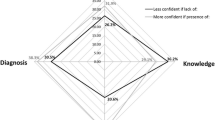Abstract
In a study designed to evaluate the effects of an educational program and an antibiotic order form on the quality of antimicrobial drug use, a prospective analysis was conducted in the department of internal medicine of a 948-bed university hospital. Following a quality-of-use review of all consecutive courses of antimicrobial drugs prescribed during four weeks, an educational program was conducted and an antibiotic order form introduced. After four years, an identical review was performed. In the first review, 109 (31%) of 347 patients were prescribed antimicrobial drugs. Only 40% of the prescriptions were considered definitely appropriate, and 13% were considered unjustified. There was a certain degree of underutilization, and only 67% of clinical isolates were susceptible to empirical therapy. In the review performed after intervention, 164 (21%) of 796 patients were given antimicrobial drugs. Defined daily doses per 100 bed days increased from 59.8 to 72.6. Fifty-three percent of the prescriptions were judged optimal, and only 9% were judged unjustified. Ninety percent of the clinical isolates were susceptible to empirical therapy. After one year, compliance with the antibiotic order forms on a voluntary basis reached 77%, documenting 86% of antimicrobial drug costs. As a result, the antibiotic order form will be useful for surveillance, if logistic support is provided by the pharmacy. The combination of several measures leads to improved quality of use. As correctly predicted by the first evaluation, improvement in quality resulted in increased drug consumption by fewer patients and a higher cost per bed day.
Similar content being viewed by others

References
Kunin CM, Staehr Johansen K, Worning AM, Daschner FD: Report of a symposium on use and abuse of antibiotics worldwide. Reviews of Infectious Diseases 1990, 12: 12–19.
Dunagan WC, Woodward RS, Medoff G, Gray JL III, Casabar E, Lawrenz CA, Spitznagel E, Smith MD: Antibiotic misuse in two clinical situations: positive blood culture and administration of aminoglycosides. Reviews of Infectious Diseases 1991, 13: 405–412.
Cohen ML: Epidemiology of drug resistance: implications for a post-antimicrobial era. Science 1992, 257: 1050–1055.
Janknegt R, Wijnands WJA, Caprasse M, Brandenburg W, Schuitenmaker MG, Stobberingh E: Antimicrobial drug use in hospitals in the Netherlands, Germany, and Belgium. European Journal of Clinical Microbiology & Infectious Diseases 1993, 12: 832–838.
Kunin CM: Use of antibiotics: a brief exposition of the problem and some tentative solutions. Annals of Internal Medicine 1973, 79: 555–560.
Gyssens IC, Van den Broek PJ, Kullberg BJ, Hekster YA, Van der Meer JWM: Optimizing antimicrobial therapy. A method for antimicrobial drug evaluation. Journal of Antimicrobial Chemotherapy 1992, 30: 724–727.
Jones SR, Barks J: The effect of an educational program upon hospital antibiotic use. American Journal of the Medical Sciences 1977, 273: 79–85.
Avorn J, Soumerai SB, Taylor W, Wessels MR, Janousek J, Weiner M: Reduction of incorrect antibiotic dosing through a structured educational order form. Archives of Internal Medicine 1988, 148: 1720–1724.
Lipsy RJ, Smith GH, Maloney ME: Design, implementation, and use of a new antimicrobial order form: a descriptive report. Annals of Pharmacotherapy 1993, 27: 856–861.
Gyssens IC, Geerligs IEJ, Dony JMJ, Van der Vliet JA, Van Kampen A, Van den Broek PJ, Hekster YA, Van der Meer JWM: Optimising antimicrobial drug use in surgery: an intervention study in a Dutch university hospital. Journal of Antimicrobial Chemotherapy 1996, 38: 1001–1012.
Garner JS, Jarvis WR, Emori TG, Horan TC, Hughes JM: CDC definitions for nosocomial infections, 1988. American Journal of Infection Control 1988, 16: 128–140.
World Health Organisation: Anatomical therapeutic chemical (ATC) classification index, including defined daily doses (DDDs) for plain substances. WHO Collaborating Centre for Drug Statistics Methodology, Oslo, January 1993.
Gyssens IC, Lennards CA, Hekster YA, Van der Meer JWM: The cost of antimicrobial chemotherapy: a method for cost evaluation. Pharmaceutisch Weekblad Science 1991, 13: 248–253.
Quintiliani R, Nightingale CH, Crowe HM, Cooper BW, Bartlett RC, Gousse G: Strategic antibiotic decisionmaking at the formulary level. Reviews of Infectious Diseases 1991, 13, Supplement 9: 770–777.
Blok WL, Gyssens IC, Hekster YA, Koopmans PR Van der Meer JWM: Feasibility of an antibiotic order form. First experience in the department of internal medicine in a university hospital. Pharmacy World & Science 1996, 18: 137–141.
Marr JJ, Moffet HL, Kunin CM: Guidelines for improving the use of antimicrobial agents in hospitals: a statement by the Infectious Disease Society of America. Journal of Infectious Diseases 1988, 157: 869–876.
Moss F, McNicol MW, McSwiggan DA, Miller DL: Survey of antibiotic prescribing in a district general hospital I. Pattern of use. Lancet 1981, ii: 349–352.
Echols RM, Kowalsky SF: The use of an antibiotic order form for antibiotic utilization review: influence on physicians' prescribing patterns. Journal of Infectious Diseases 1984, 150: 803–807.
Durbin WAJ, Lapidas B, Goldmann DA: Improved antibiotic usage following introduction of a novel prescription system. Journal of the American Medical Association 1981, 246: 1796–1800.
Scher KS, Bernstein JM, Arenstein GL, Sorensen C: Reducing the cost of surgical prophylaxis. American Surgeon 1990, 56: 32–35.
Pestotnik SL, Evans RS, Burke JP, Gardner RM, Classen DC: Therapeutic antibiotic monitoring: surveillance using a computerized expert system. American Journal of Medicine 1990, 88: 43–48.
Author information
Authors and Affiliations
Rights and permissions
About this article
Cite this article
Gyssens, I.C., Blok, W.L., van den Broek, P.J. et al. Implementation of an educational program and an antibiotic order form to optimize quality of antimicrobial drug use in a department of internal medicine. Eur. J. Clin. Microbiol. Infect. Dis. 16, 904–912 (1997). https://doi.org/10.1007/BF01700557
Issue Date:
DOI: https://doi.org/10.1007/BF01700557



